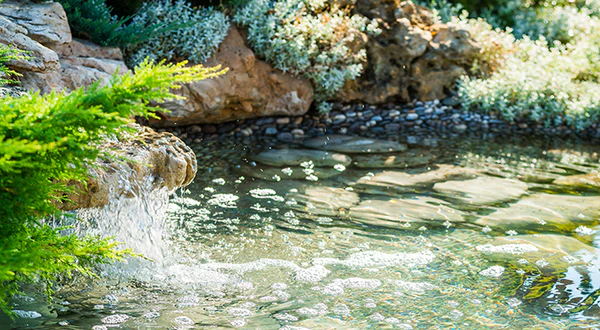Maintaining the same pristine look when algae take over ponds and turn it into a swampy and stringy mat all across the surface the algae control becomes an even more pressing need. Distressing as it seems, discouraging as it may be, an unsightly algae development within a small backyard pond or within a large land based water structure is as much of an aesthetic concern as it is an ecological one noting that far deeper ratios are at fault that would slowly junk up such construction and threaten the health of the fish and water.
Understanding the Algae Challenge
Before developing the most efficient of pond algae control measures, one must be able to differentiate between the different types of algae, as this will form the basis of the approach used for combating the algae. For instance, Bacterial and Filamentous algae are easier to deal with than Brown, Blue, and Green algae.
Filamentous Algae (String/Hair Algae)
Some algae, such as bacteria, are easy to combat. They cover the substrate and are then floated on the water in tufts. People owning ponds often complain of seeing the following:
- Green mossy mats
- Slimy, hair-like strands
- Cotton-like masses (Pithophora species)
- Silky wet hair (Spirogyra species)
These floating mats become buoyant due to the oxygen they produce during photosynthesis. While moderate amounts provide habitat and food for beneficial microorganisms, excessive growth indicates nutrient imbalances that require intervention.
Planktonic Algae (Green Water)
Often described as “pea soup,” these single-celled organisms—including diatoms—float freely throughout the water column. They can appear:
- Green
- Yellow
- Blue-green
- Brown
When water visibility drops below 18 inches due to planktonic blooms, immediate algae control for ponds becomes necessary to prevent potential fish kills.
Macro-Algae (Chara and Nitella)
Frequently mistaken for submerged aquatic plants, these complex algae form grow in stem-like structures:
- Chara (muskgrass): Features gritty, calcified coating with distinctive skunk-like odor; thrives in hard water
- Nitella: More delicate structure without calcification or odor; typically found in acidic/soft water
Unlike true aquatic plants, neither possesses actual root systems.
The Hidden Dangers of Algae Blooms
Growing algae isn’t bad, quite on the contrary, it is essential to maintaining the ideal conditions of a pond for its habitat. The devastating issue arises when these algae grow at an unsustainable rate which creates an oxygen cycle.
- Algae produce over 50% of the total oxygen during the day by accepting electrons from oxidizing water in a process called photosynthesis.
- Though the level of oxygen is high during the day, algea takes it all at night.
- If a group of extremely excessive stimulation growths happens, the dissolved oxygen in the available water will be insufficient.
- Growing blooms for the required days on end will be consuming more oxygen then they are producing.
- With all these oxygen level balances going around, there comes a time where fish can all die at once for no obvious reasons.
An excess amount of Algecides put in these enormous blooms will decay parts of the organic residue acquired meaning giving more opportunities to fish kills one wants to prevent.
The Aeration Solution for Algae Control
While the application of chemicals may provide a focused and immediate outcome, proper aeration, which is an abbreviation for over-the-pipe-fittings systems, indicates the cornerstone of a long-term solution for ponds and lakes. The following are the ways in which the aerators help in eliminating the most harmful algae types:
Oxygen Stabilization
Bottom diffuser aeration systems circulate oxygen throughout the entire water column, eliminating the stratified low-oxygen conditions where many algae thrive. This circulation:
- Maintains consistent dissolved oxygen levels day and night
- Reduces stress on fish populations
- Creates conditions where beneficial bacteria outcompete harmful algae
- Prevents the drastic oxygen fluctuations that trigger fish kills
Nutrient Management Through Circulation
Excess nutrients (particularly phosphorus and nitrogen) fuel aggressive algae growth. Proper aeration:
- Promotes the activity of beneficial aerobic bacteria that digest organic matter
- Reduces bottom muck accumulation that releases nutrients
- Prevents stratification that traps nutrients in bottom layers
- Converts ammonia, nitrite, and nitrate into harmless nitrogen gas
Temperature Regulation
By eliminating thermal stratification, aeration systems prevent the formation of warmer surface layers where algae thrive, particularly during summer months.
Comprehensive Algae Control Strategies
For optimal algae control for ponds, integrate aeration with these complementary approaches:
Targeted Algaecide Treatments
Choose appropriate formulations based on your specific algae type:
For Filamentous/String Algae:
- Cutrine Plus Granular (applied to bottom-growing colonies)
- Hydrothol Granular (dual-action herbicide/algaecide)
- GreenClean Pro (peroxide-based alternative to copper)
For Planktonic/Green Water:
- Cutrine Plus Liquid
- Blue Stone Crystals (copper sulfate)
For Chara/Nitella:
- Copper-based treatments like Cutrine Plus
Sunlight Limitation
Consistent application of pond dye blocks photosynthesis-promoting sunlight from penetrating to bottom substrates where algae begin growth cycles. This preventative approach:
- Limits algae’s ability to photosynthesize
- Creates unfavorable growing conditions
- Enhances aesthetic appearance with blue or black tinting
- Complements other treatment methods
Biological Nutrient Reduction
Beneficial bacteria treatments consume the excess nutrients that fuel algae blooms:
- Bacteria digest ammonia, nitrites, and nitrates
- These nutrients convert to harmless nitrogen gas
- Regular applications establish beneficial bacterial colonies
- Clean Pond Maintenance Kits provide sustained biological support
Comprehensive Management Packages
The Algae Control Pond Package or Clean Pond Maintenance Kits are some of the most integrated treatment packages, this approach needs to be approached concerning the ponds specific size, which is available for 1/4 acre, 1/2 acre, and 1-acre pond practice.
Implementation Timeline for Effective Control
For the effective control of algae in ponds, the approach to hypothesized growth should be proactive, seasonal, and strategic. Right from the start of spring, while temperatures aren’t too high, introduce or restart aeration systems to maintain a constant water movement across the pond and apply an initial treatment of pond dye, concentrating treatment on the bottom to limit photosynthesis and grow beneficial bacteria. The targeted measures outlined in this phase are essential to the control of algae species, thereby laying a good foundation for eradicating any vexing issues before the algae can emerge.
Throughout the active growth season (late spring through summer), maintain vigilant management with 24/7 aeration operation, consistent bacteria applications every 2-4 weeks, and periodic pond dye refreshment as needed to maintain limited light penetration. This period requires careful monitoring of developing algae colonies, with targeted spot treatments using appropriate algaecides when necessary—always treating in sections (maximum 1/3 of pond area at once) to prevent oxygen depletion from sudden mass die-off of algae. Regular water quality testing during this phase helps identify developing problems before they become severe.
As temperatures begin to decline in fall, transition to preparation strategies that reduce organic matter while maintaining circulation patterns through winter. Continue aeration appropriate for your climate (full operation in mild regions, modified approaches in freezing conditions), service equipment during the dormant season, and address watershed management to reduce next season’s nutrient inputs. This comprehensive annual cycle creates a sustainable approach to algae control for ponds by addressing the fundamental causes of excessive growth rather than simply reacting to symptoms, ultimately resulting in clearer water with significantly reduced maintenance requirements.
Special Considerations for Different Pond Types
Recreational Fishing Ponds:
- Prioritize dissolved oxygen stability to protect fish populations
- Consider larger aeration systems scaled to pond volume
- Monitor potential impacts of treatments on fish health
- Maintain detailed treatment records to track effectiveness
Landscape/Ornamental Ponds:
- Balance aesthetic concerns with ecological health
- Consider combining fountain aerators (visual appeal) with bottom diffusers (biological benefit)
- Select appropriate dyes to enhance visual appearance while limiting algae
Koi/Ornamental Fish Ponds:
- Use fish-safe treatment options at conservative application rates
- Implement robust filtration alongside aeration
- Monitor water parameters more frequently during treatment phases
The Long-Term Approach to Algae Management
The sustainable control of algae blooms is not solely about removing the flourishing blooms, but addressing the core probable causes of the problem allowing excessive algae growth:
- Nutrient Reduction: Minimize external inputs through proper watershed management, buffer zones, and runoff control
- Ecosystem Balance: Support diverse beneficial organisms that compete with problematic algae
- Consistent Circulation: Maintain year-round aeration to prevent stratification
- Regular Maintenance: Remove accumulated organic matter that releases nutrients during decomposition
- Monitoring: Test water regularly to identify developing issues before they become problematic
Conclusion
Success in long-term algae control in ponds can only be achieved by correctly taking into account the relation of nutrients, oxygen, beneficial bacteria, and the various algae species growth cycles. Algaecides are in some cases used for attacking active blooms, but long term efficacy hinges on establishing an environment where frustrating algal species cannot outcompete.
Installing correct aeration is the most important base on which to build, after which provide targeted treatments, pond dyes and beneficial bacteria. This integrated management is a sure way of improving the aesthetic look as well as achieving a healthier water environment, which in turn contributes to the overall enjoyment of the water feature during the year.
For specific treatment recommendations tailored to your unique pond conditions, consult with water quality professionals who can analyze your particular algae challenges and develop a customized management plan that addresses both immediate concerns and long-term prevention.







